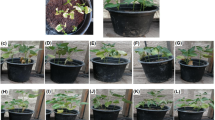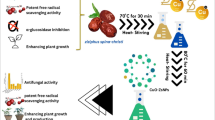Abstract
Today aggressive agricultural efforts to increase crop productivity have sparked new research formulations for innovative fertilizers and natural insecticides, particularly those incorporating nanomaterials. For the first time, bioengineered ZnO NPs (nanoparticles) were done employing peel waste of vegetable extruent as a major mediator to boost the value of cluster beans (Cyamopsis tetragonoloba) seeds as well as the higher yield of cluster beans pods. The findings of several phytochemical property investigations show the creation of ZnO NPs. The agar well method was used to explore the antagonistic efficiency of plant pathogens like Staphylococcus aureus, Bacillus cereus, Pseudomonas aeruginosa, Salmonella typhimurium, Candida albicans, and Candida glabrata. For, cluster beans foliar sprays of bioengineering based ZnO nano-fertilizer at varied doses were applied. Among the various concentrations tested, the plant obtained 20 mg/L had the utmost bioactive contents in comparison to the control. Growth characters such as germination of seeds (95%), total plant length (37 cm), shoot length (20 cm), root length(8.2 cm), gross wet weight (25 gm), shoot wet weight (18 gm), root wet weight (1.92 gm), gross dry weight (6.68 gm), shoot dry weight (5.81 gm), root dry weight (0.49 gm), branch numbers (11), leaf expanse (8.9 cm), pod numbers (15), length of the pod (19.6 cm) and weight of the pod (0.126 gm) this sort of seed was recognized as being superior to hydro-primed seeds. From this investigation,we resolved that the bioengineered ZnO NPs has been effectively realized and is a biocompatible,less-toxic, ecologically friendly substance. ZnO NPs thereby synthesized proved to have exceptional antimicrobial potential against pathogens in plants as well as remarkable results in improving the growth and yield of cluster beans. Therefore, a bioengineering-based ZnO nano fertilizer can be recommended for agricultural applications.






Similar content being viewed by others
References
Abd Elhady MM (2012) Preparation and characterization of chitosan/zinc oxide nanoparticles for imparting antimicrobial and UV protection to cotton fabric. Int J Carbohydr Chem. https://doi.org/10.1155/2012/840591
Abdel-Aziz HMM, Hasaneen MNA, Omer AM (2016) Nano chitosan-NPK fertilizer enhances the growth and productivity of wheat plants grown in sandy soil. Span J Agric Res 14:902–911
Alamdari S, SasaniGhamsari M, Lee C, Han W, Hyung-Ho P, Tafreshi MJ, Afarideh H, Majles AMH (2020) Preparation and characterization of zinc oxide nanoparticles using leaf extract of Sambucus ebulus. Appl Sci 10(10):3620. https://doi.org/10.3390/app10103620
Avinash A, Pandey S, Sanjay S, Yadav S (2010) Application of ZnO nanoparticles in influencing the growth rate of Cicerarietinum. J Exp Nanosci 5:488–497
Chikaodili C, O’Donnell S, Karri K, Salem L, Jay S, Obioma U, Bolade A, Linus O, Wan Jin J (2014) Synthesis of C5–C22 hydrocarbon fuel from ethylene-based polymers. Int J Sci Eng Res 5(8):805–809
Elemike EE, Fayemi OE, Ekennia AC, Onwudiwe DC, Ebenso EE (2017) Silver nanoparticles mediated by costusafer leaf extract: synthesis, antibacterial, antioxidant and electrochemical properties. Molecules 22:701
Elias E, Saiyed T, Anthony C, Onwudiwe DC (2019) Silver nanoparticles mediated by extract of Guar plant (Cyamopsis tetragonoloba), and evaluation of their photocatalytic and antibacterial properties. Adv Mater Lett 10(4):284–293
Gresta F, Ceravolo G, Presti VL, Agata A, Rao R, Chiofalo B (2017) Seed yield, galactomannan content and quality traits of different guar (Cyamopsis tetragonoloba L.) genotypes. Ind Crop Prod 107:122
Hafeez B, Khanif M, Saleem M (2013) Role of zinc in plant nutrition: a review. Am J ExpAgric 3:374–391
Jaksomsak P, Tuiwong P, Rerkasem B, Guild G, Palmer L, Stangoulis J (2018) The impact of foliar applied zinc fertilizer on zinc and phytate accumulation in dorsal and ventral grain sections of four Thai rice varieties with different grain zinc. J Cereal Sci 79:6–12
Jayarambabu N, Siva Kumari B, Venkateswara Rao K, Prabhu YT (2015) Beneficial role of zinc oxide nanoparticles on green crop production. Int J Multidiscip Adv Res Trends II(I):273–282
Kasi G, Seo J (2019) Influence of Mg doping on the structural, morphological, optical, thermal, and visible-light responsive antibacterial properties of ZnO nanoparticlessynthesized via co-precipitation. Mater Sci Eng C 98:717–725
Kasi G, Viswanathan K, Seo J (2019) Effect of annealing temperature on themorphology and antibacterial activity of Mg-doped zinc oxide nanorods. Ceram Int 45:3230–3238
Keerthana P, Vijayakumar S, Vidhya E, Punitha VN, Nilavukkarasi M, Praseetha PK (2021) Biogenesis of ZnO nanoparticles for revolutionizing agriculture: a step towards anti-infection and growth promotion in plants. Ind Crops Prod 170:113762
Khalaf AA, Sahar A, Jean Z, Chafic S (2017) Synthesis of ZnO nanopowders by using sol-gel and studying their structural and electrical properties at different temperature. Energy Procedia 119:565–570
Kim I, Viswanathan K, Kasi G, Thanakkasaranee S, Sadeghi K, Seo J (2020) ZnO nanostructures in active antibacterial food packaging: preparation methods, antimicrobial mechanisms, safety issues, future prospects, and challenges. Food Rev Int 38(4):537–565
Manoj VV, Karthika M, Praveen Kumar VSR, Boomadevi S, Jeyadheepan K, Karn RK, John Bosco Balaguru R, Pandiyan SK (2014) Synthesis of ZnO nanoparticles using carboxymethyl cellulose hydrogel. Asian J Appl Sci 7:798–803
Manuela S, Adriana P, Dana T, Silipas TD, Dan CV (2016) Antibacterial and antioxidant activities of ZnO nanoparticles synthesized using extracts of Allium sativum, Rosmarinus officinalis, and Ocimum basilicum. Acta Metall Sin (Engl Lett) 29(3):228–236
Minha N, Aslam U, Khalid B, Chen B (2020) Green route to synthesize zinc oxide nanoparticles using leaf extracts of Cassia fistula and Meliaazadarach and their antibacterial potential. Sci Rep 10(1):9055
Pan K, Zhong Q (2016) Organic nanoparticles in foods: fabrication, characterization, and utilization. Annu Rev Food Sci T 7:245–266
Prakashraj R, Vijayakumar S, Punitha VN, Vidhya E, Nilavukkarasi M, Praseetha PK (2021) Fabricated TiO2 nanofertilizers for foliar assimilation to enhance yield and disease resistance in Capsicum annuum L. J Plant Growth Regul. https://doi.org/10.1007/s00344-021-10520-1
Prasad R, Bhattacharyya A, Nguyen QD (2017) Nanotechnology in sustainable agriculture: recent developments, challenges, and perspectives. Front Microbiol 8:1014
Raghavendra CK, Srinivasan K (2015) Potentiation of anti cholelithogenic influence of dietary tender cluster beans (Cyamopsis tetragonoloba) by garlic (Allium sativum) in experimental mice. Indian J Med Res 142:462
Umavathi S, Ramya M, Padmapriya C, Gopinath K (2020) Green synthesis of zinc oxide nanoparticle using justiciaprocumbense leaf extract and their application as an antimicrobial agent. JBAPN 10:153–164
Umavathi S, Mahboob S, Govindarajan M, Al-Ghanim KA, Ahmed Z, Virik P, Al-Mulhm N, Subash M, Gopinath K, Kavitha C (2021) Green synthesis of ZnO nanoparticles for antimicrobial and vegetative growth applications: a novel approach for advancing efficient high quality health care to human wellbeing. Saudi J Biol Sci 28:1808–1815
Vijayakumar S, Durgadevi S, Arulmozhi P, Rajalakshmi S, Gopalakrishnan T, Parameswari N (2019) Effect of seaweed liquid fertilizer on yield and quality of Capsicum annum L. Acta Ecol Sin 39(5):406–410
Wali M, Naimat U, Muhammad H, Bilal HA (2019) Optical, morphological and biological analysis of zinc oxide nanoparticles (ZnO NPs) using Papaversomniferum L. RSC Adv 9:29541. https://doi.org/10.1039/c9ra04424h
Acknowledgements
The authors thank the DST-SERB (SB/YS/LS-109/2014) and DST-FIST (SR/FST/College- 222/2014) for granting funds for this project. We do register thanks to the authorities of A.V.V.M. Sri Pushpam College (Autonomous), Poondi, for imparting the required support for this work
Author information
Authors and Affiliations
Corresponding author
Ethics declarations
Conflict of interest
The authors declare that they have no conflicts of interest concerning this article.
Additional information
Publisher's Note
Springer Nature remains neutral with regard to jurisdictional claims in published maps and institutional affiliations.
Rights and permissions
About this article
Cite this article
Rexlin, J., Vijayakumar, S., Nilavukkarasi, M. et al. Bioengineered ZnO nanoparticles as a nano priming agent in Cyamopsis tetragonoloba (L).Taub. to improve yield and disease resistance. Appl Nanosci 13, 5993–6001 (2023). https://doi.org/10.1007/s13204-022-02526-2
Received:
Accepted:
Published:
Issue Date:
DOI: https://doi.org/10.1007/s13204-022-02526-2




